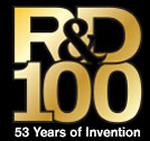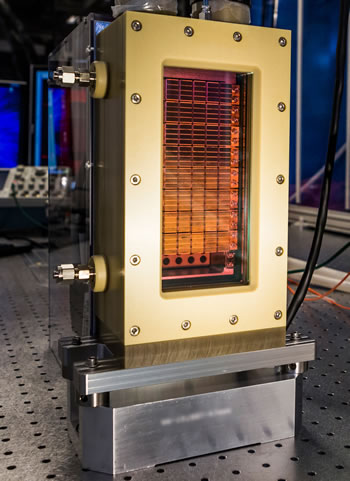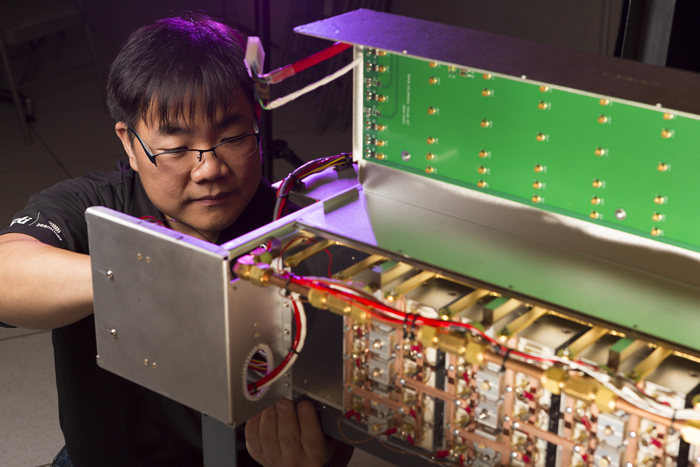Science & Technology - 2015
November
New Laser Pump Wins R&D 100 Award

A new laser pumping system developed for LLNL’s High Repetition Rate Advanced Petawatt Laser System (HAPLS) project has been named one of the top 100 industrial inventions worldwide for 2015. The trade journal R&D Magazine announced the winners of its annual R&D 100 awards, sometimes called the “Oscars of Invention,” on Nov. 13; LLNL won a total of three awards.
With this year’s results, the NIF & Photon Science Directorate and its predecessor, the Laser Programs directorate, have captured 62 R&&D 100 awards out of a total of 155 won by LLNL since 1978.
The new pumping system, known as the High-power Intelligent Laser Diode System (HILADS), employs advances in laser diodes and electrical drivers to achieve two-to-three-fold improvements in peak output power and intensity  A HILADS diode array populated in an 8x5 channel configuration. This single array produces 0.8 megawatts of peak optical power, making it the world’s highest peak power laser diode array.over existing technology. The system is 10 times more compact than other pumping systems and can scale to even larger arrays and power levels.
A HILADS diode array populated in an 8x5 channel configuration. This single array produces 0.8 megawatts of peak optical power, making it the world’s highest peak power laser diode array.over existing technology. The system is 10 times more compact than other pumping systems and can scale to even larger arrays and power levels.
HILADS was developed by a team of LLNL scientists and engineers in partnership with Tucson, Arizona-based Lasertel. The system has produced 3.2 megawatts of peak optical power from four pump systems at a 10-Hz (10 times a second) repetition rate in its largest power output to date. The project’s principal investigators are Bob Deri from LLNL and Prabhu Thiagarajan, vice president of Engineering, from Lasertel.
Pulsed laser diode arrays such as HILADS are essential for energizing the next-generation high energy solid-state lasers that run at frequencies above 5 Hz. Applications for these high-repetition-rate laser systems are scientific exploration, laser-generated particle beams, materials processing, defense applications, and medical applications.
HILADS has been deployed on HAPLS, the high repetition rate petawatt laser system that LLNL is developing for the European Light Infrastructure Beamlines (ELI- Beamlines) facility. ELI-Beamlines will use high-energy diode-pumped lasers to study high-intensity light-material interaction physics, with expected spinoffs for industrial and medical technologies.
The new pumping system improves upon other laser technologies by providing significantly more optical power at significantly higher intensity in a system with a substantially smaller footprint and a higher degree of integration. These developments enable the creation of more energetic laser systems that exhibit higher wallplug efficiency.
 HAPLS Power Conditioning Team member Ed Koh adjusts the HILADS electrical drivers. Credit: Damien Jemison
HAPLS Power Conditioning Team member Ed Koh adjusts the HILADS electrical drivers. Credit: Damien Jemison HILADS enabled the HAPLS pump laser system to produce 71 joules of infrared laser energy and 41 joules of second-harmonic (green) energy last month, marking the completion of the system’s first energy-ramping campaign (see “HAPLS Completes Phase 1 Energy-Ramping Campaign”).
Along with Deri, LLNL contributors to HILADS were Steve Telford, Andy Bayramian, Steve Fulkerson, Ed Koh, Constantin Haefner, Jeff Jarboe, John Peterson, Rod Lanning, Ken Charron, Dan Mason, Jeff Horner, Paul Rosso, Chuck Heinbockel, Brian Heidl, Glenn Beer, Carlene Kiker, Cheryl Stockton, Keith Primdahl, Steve Pratuch, Scott Wilcox, Jim Sullivan, Ron Shaw, Dale Jose, Mauro Cerda, and Tara Silva.



